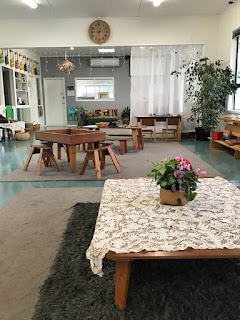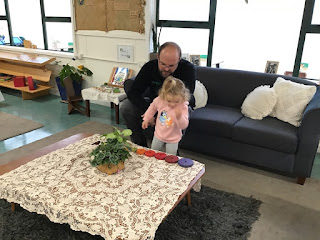Over our last term break Kaiako worked collaboratively to change our inside environment, taking careful consideration regarding what we wanted to achieve. Our objective was to create a calm environment that reflected who we are, our philosophy, our kindergarten pepeha and the whanau and their tamariki. We wanted open spaces but spaces that allowed tamariki to have quiet time and encouraged independence.
The environment needs to invite children to become involved and encourage them to explore a wide variety of materials (Fraser & Gestwicki, 2002).
Firstly, we looked at our first impressions, i.e. what did we see when we walked through our front doors. First impressions give a small glimpse into what else is to come, and also a sense of the atmosphere and priorities of our kindergarten.
Whakawhanaungatanga is central to our philosophy. Kanohi ki te kanohi (face to face conversations) is something that we value immensely, and this is what we wanted our first impressions to reflect. We also reflected on the question in Te Whariki; “What features of the ECE environment help children and whānau feel that this is a place where they belong?”
We
began by moving our couch/whānau area closer to the front of our environment, while
also adding a shelf to display all our whanau photos and the clay creations that
tamariki have made. Portfolios of the tamariki, plants and fresh cushions finished
the space, creating a sense of calm.
This
space provides our parents and whanau with opportunities to spend time in our
environment while not feeling like they are in the center of the learning
environment. Since the changes we have noticed many parents and whanau
utilising this space, while tamariki are using this space to revisit their
learning by exploring their portfolio books.
“It’s
open and inviting and great to see whanau pictures and couches when you walk
in the door”- spontaneous feedback.
As we move through our inside environment you can now
find a new book nook, providing tamariki with opportunities to relax. We then have our
puzzles and an area to explore the light table, tabletop activities and more.
Our block area is still situated at the back of our environment which also
converts into our mat space.
"Collaboration is one of the strongest messages that the environment, in its role as the third teacher communicates. An environment that is planned to act as the third teacher is particularly effective in helping children learn skills for working with others in a group.” (Fraser & Gestwicki, 2002,).
We have plants and white sheer curtains framing our spaces including our art space which is off to the side.
“I love that the art space is all together, utilising the art studio that was created years ago” – spontaneous feedback.
Our changes now are
in line with our philosophy which states “our secure and warmly respectful
environment supports tamariki to explore and play freely. This fosters their
ability to be active learners and leaders” (Mairtown Kindergarten philosophy).
Ngā mihi nui
Emma Quigg











